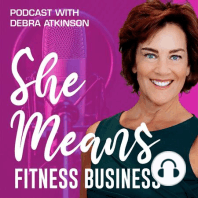36 min listen

10 Things to Know About Osteoporosis Fitness Clients
10 Things to Know About Osteoporosis Fitness Clients
ratings:
Length:
18 minutes
Released:
Oct 7, 2023
Format:
Podcast episode
Description
October is Menopause Awareness Month and October 20 is Osteoporosis Day, so it’s only fitting we discuss the truths about working with osteoporosis fitness clients. Questions are abundant both among women diagnosed and trainers and coaches working with them. Information once on the internet lives on the internet and it’s up to you to filter through it. Here’s a little vetted information to help. Several references are included, but I encourage you to take your own primary research further. If you’re working with someone with osteoporosis or osteopenia or you want to be a part of preventing it, you owe it to them and yourself to do your homework. Prior to dogma about weight management and lack of consistent information about prevention of bone loss are big contributors to a woman’s risk of osteoporosis After diagnosis fear is the biggest obstacle many women face due to decades-long information that women with osteoporosis are delicate and should do less At this time 50% of women diagnosed with osteoporosis suffer a fracture During menopause transition bone loss can accelerate to 4% a year for up to 10 years according to previous studies reported by John Hopkins Misinformed from perpetuating outdated information from both doctors and trainers (since 2015 evidence of not only increased safety and viability of high impact and high intensity exercise for osteoporotic postmenopausal women is much more promising than prior goals of stopping or slowing losses) 41% of women over 40 had either osteopenia (>31%) or osteoporosis (>14%) in a 2010 study. Said differently, 31% of women over 40 had osteopenia and more than 30% of women over 60 had osteoporosis. The further from menopause (>10 years the increase in prevalence of osteoporosis = 40% compared to just 5 years post menopause at 9%) It’s not only about calcium, it’s about whether it’s absorbed. Yes, to Vitamin D and magnesium but if gut issues persist and a woman is tolerating them or describing as “normal for me” there’s a potential gap Intense weight training and high impact exercise have been safely employed in a number of studies since 2015 with positive results, no negative effects and a high adherence rate Yoga too has been proven to improve bone density with a daily practice of 12 poses each held for a minute Whole body vibration increased BMD by 2% with 5 minutes 3x a week in postmenopausal women. In physically restricted individuals it’s an alternative to other exercise. In able-bodied, in combination with resistance training WBV increases results of both muscle and bone regeneration. “Whole-body vibration therapy is an intentional biomechanical stimulation of the body using various frequencies of vibrations with the motive of health improvement. Ever since its discovery, this therapy has been extensively used in physiotherapeutic measures and the sports industry. For its property of increasing bone mass and density, space agencies use this therapy on astronauts who return to Earth after long-term space missions to regain lost bone and muscle mass. The potential of this therapy to restore bone mass encouraged researchers to look for its scope in the treatment of age-related bone degenerative diseases such as osteoporosis and sarcopenia, as well as in the correction of posture control and gait in geriatrics and post-menopausal women.” First used by NASA with astronauts as a way to overcome the muscle and bone losses experienced by astronauts in space. affects bone metabolism, muscle function, muscle training, and the endocrine system Vibration therapy provides anabolic mechanical signals to the bone and musculotendinous systems It improves blood circulation to the bones, ensuring an improved nutrition supply. Human adipose-derived stem cell differentiation into osteoblasts is facilitated by vibration therapy inhibiting excessive osteoclast formation improves bone health by amplifying gap junctional communication in osteocytes
Released:
Oct 7, 2023
Format:
Podcast episode
Titles in the series (100)
Gaining Power With Fitness Clients and Careers With Your Personality: Professional and personal growth requires forward momentum but its best combined with inner reflection. Using the power of your personality to enhance relationships and awareness of how you impact other people. At any age and phase of career you use... by She Means Fitness Business